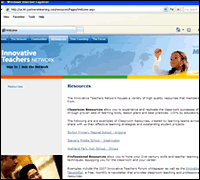
Teachers across the United States will have an opportunity to communicate and collaborate with top-notch educators from all over the world through Microsoft Corp.’s Innovative Teachers Network (ITN), a new online forum that promotes the exchange of ideas and methods on how best to incorporate technology into the classroom effectively.
The ITN is part of Microsoft’s Partners in Learning (PiL) initiative, a program that gives educators the resources, training, and content they need to complement classroom technology and allow students to reach their full potential.
In this newest boost of funding to PiL, Microsoft officials say educators will see a focus on programs that can support innovative students.
“What the U.S. needs the least is another database of lesson plans,” said Mary Cullinane, director of Microsoft’s U.S. Partners in Learning program. “What we do need, and what we believe is of significant value, is a place for innovative teachers and educators to have access to high-quality resources, to have an area for sharing best practices in learning communities, to communicate and collaborate with colleagues, and … to expose [educators] to a worldwide conversation.”
Cullinane said the ITN will connect nearly 1 million educators around the world.
“It’s exciting for the U.S. to be part of that [international] conversation,” Cullinane said. “[Teachers] will now have access to the world’s largest professional development community for educators by being a part of this.”
Microsoft has been testing the ITN for roughly six months, and U.S. educators have already given positive feedback.
“Sometimes what we do in the tech industry is we over-engineer, especially in the education phase,” Cullinane said. “From the beginning … [we tried] to keep it simple, and we made sure that the interface and the experience is something intuitive, so users can pick it up quickly.”
Within the network, educators can create their own communities, start discussions, and collaborate with other educators who have similar interests. And because of that, it is very much user-driven, Cullinane said. Users can initiate threads and conversations, and they can create communities with pre-set lists of attendees or members.
“We’ll see more and more educators asking for and thriving on these communities,” Cullinane predicts. “From a classroom perspective, I can’t tell you the number of times where an institution’s biggest challenge was that the math teachers in their school weren’t collaborating with one another. It’s those real-world challenges that technology can help alleviate.”
The ITN also might help cut down on the amount of time teachers spend searching for tips or solutions for classroom practices or problems.
As educators search for information, they can become inundated with results and must spend time sorting through material and judging its appropriateness, Cullinane explained.
“I think what the ITN does is provide that quality filter–this is a place educators can go and know that their time is going to be well-used,” she said. “The network also allows for an opportunity to exchange tips and tricks.”
Cullinane added that the ITN is an example of how technology can be very effective in fostering communication and collaboration.
“I think we could ask all the time how technology is going to make a difference,” she said. “Fundamentally, when you look at areas where technology can have the biggest impact, communication and collaboration are top on the list.”
The network could help educators, both new and experienced, realize they are not the only ones dealing with classroom problems or frustrations.
“At the end of the day, people want friends,” Cullinane said. “No matter what your job is, it’s great to know there are other people out there with the same challenges, concerns, and opportunities.”
The launch of ITN accompanies news that Microsoft is beefing up funding and support for its PiL core programs–Innovative Teachers, Innovative Students, and Innovative Schools. PiL is a key education initiative under Microsoft Unlimited Potential, the company’s commitment to making technology more affordable, relevant, and accessible for everyone through equipment, training, and partnerships that focus on transforming education, fostering local innovation, and creating jobs and opportunities.
PiL does not represent a one-size-fits-all approach to education. Microsoft officials say the initiative’s goal is to satisfy the diverse needs of everyone involved in education–from policy makers and ministries of education to teachers, students, and parents. Much of the program’s focus is on holistic reform and examining how school stakeholders can help create cultures of change and support innovative teachers.
This renewed commitment will bring the company’s total 10-year investment in PiL to approximately $500 million and will reach an estimated 259 million additional students and teachers around the world by 2013, Microsoft said.
Links:
Microsoft Partners in Learning
- An overwhelming majority of organizations paid ransomware last year - May 9, 2024
- 5 trends impacting higher ed’s path in 2024 - May 8, 2024
- Are AI skills more important than degrees? - May 2, 2024

